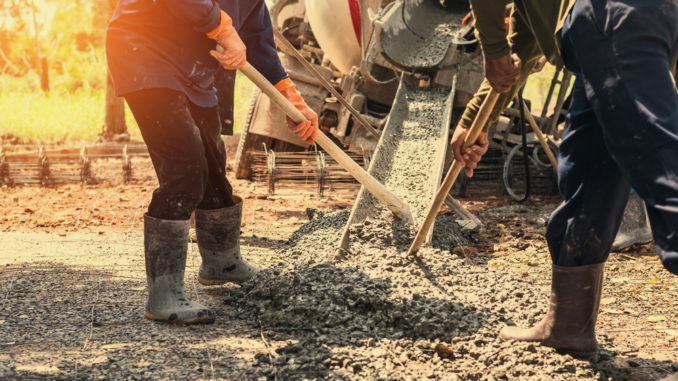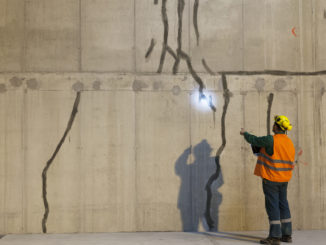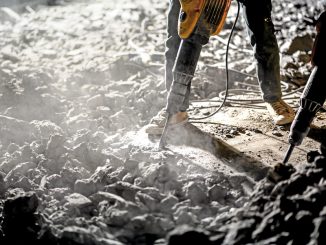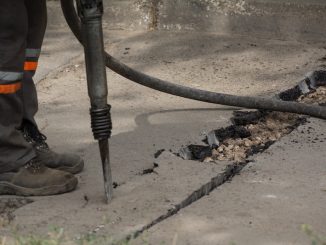
Several compounds are needed to create concrete: aggregates, cementitious materials, water, and chemical admixtures. Alone, each of these ingredients isn’t sufficient to form a hardened slab. But, the solid concrete is created when everything is mixed together and given a few hours to solidify. A critical part of this process is the hydration, which is a sequence of chemical reactions that happen between the cement and water.
Within the first few hours of mixing, these chemical reactions play a part in the behavior of the concrete slab after it hardens. Reactions continue to occur, which affects the durability and strength of the concrete. Understanding these reactions make it possible to improve the outcome of the concrete pouring to match the needs of each project.
An Overview of the 5 Stages of Hydration
The hydration process occurs as soon as the cement and water come into contact. Some of the particles of the cement start to dissolve, which results in the chemical reaction. These compounds have different rates of dissolving, which means that the chemical reactions take place at different times.
The commonly used Portland cement has three primary ingredients that play a part in these chemical reactions:
- Gypsum (calcium sulfates)
- Aluminates (calcium aluminates)
- Silicates (calcium silicates)
Five stages of hydration occur, with heat changes happening at every stage. If the system and ingredients are balanced, then you can usually expect the materials to perform as designed, according to the stages listed below.
- Mixing: The heat spikes briefly. Within minutes of the mixing, the gypsum and aluminates dissolve and react quickly, and new compounds are developed, which generates the heat. The reactions need to stay in check to avoid early stiffening of the concrete.
- Dormancy: No heat is generated. For about 2 to 4 hours, the aluminate reactions are controlled. The crew has time to transport, place, and finish the project while the concrete is workable.
- Hardening: A steady, significant rise in heat occurs. Eventually, the water is saturated with the calcium ions that have dissolved, so new compounds begin to form. At this point, the mixture starts to stiffen. Once the initial set has occurred, then no additional work should be done on the concrete. Only a curing compound can be applied to manage the evaporation on the concrete.
- Cooling: After the heat peaks, there is a consistent drop in temperature. The changes that happen to the moisture content and temperature cause the concrete to shrink. Joints need to be sawed to control the cracking locations as the materials shrink. The sawing window usually lasts between two and four hours.
- Densification: Minimal heat is generated during this phase, which is the final stage of hydration. The products continue to mesh and grow, creating the solid mass that is desired. The materials continue to strengthen, but a waiting period is needed before traffic and construction equipment move across the concrete slab.
Compounds that are Needed for Hydration
Generally, Portland cement consists primarily of clinker (made of two silicates and two aluminates) which is ground with gypsum. About 75% of the cement is composed of silicates. It is important to have Alite, which helps with the early strength and initial set of the concrete. At the same time, Belite is also needed to help with strength gain about a week after the cement it laid.
Additionally, the cement contains Tricalcium Aluminate, which hydrates immediately when it comes in contact with water. But, Calcium Sulfate can be used in the mixture to control the hydration rate. Tetracalcium Aluminoferrite is another substance that is commonly present, with the purpose to create the grey color for the cement.
Fineness of the Cement and the Hydration Properties
The fineness of the materials will affect the concrete properties and the hydration rates. If a higher hydration rate is needed, then it is better to choose finer cement mixes. The fineness of the cement can be controlled during the manufacturing process. The clinker is created in the kiln; then it is put in a grinding mill to reduce the size of the particles into a powder.
When the fineness of the cement mixture increases, then you can expect these characteristics:
- The initial hydration rate increases, which improves the early strength of the concrete.
- The heat of the hydration increases as well.
- Workability is reduced.
- Bleeding is decreased.
- There is a possible risk of reduced air entrainment
- A higher risk of incompatibility.
Complexity of Portland Cement Hydration
There’s no question that this hydration process can be complex, which is why you need to understand the reactions to control the outcome of the cement. Once the mixing begins, there is a series of chemical reactions that are nonreversible. So, it is important to select the right compounds and ratios before the mixing starts. As soon as the materials come in contact with water, the hydration process will begin.
The initial reaction happens due to the way the Tricalcium Aluminate reacts, which is why sulfates are needed to control the reaction and prevent premature stiffening. Even though the silicate reactions happen more slowly, these reactions ultimately dominate the hydration and affect most of the cement properties.
Each of the chemical reactions at different stages of hydration has implications for the process of laying the pavement. Placement curing, joint sawing, and setting time need to be planned to match the properties of the cement materials that you are using.
If you are using concrete that has low permeability, then it is essential to achieve the right ratio with the water and cementitious materials. The ideal scenario is that the hydration products will fill the space that was originally occupied by the water. There is a balance to add enough water to allow workability of the mix, without adding too much water that reduces the durability of the concrete.
As long as unhydrated cement grains and water are present, then hydration will continue for a long time. During this period, the strength of the concrete continues to improve. At the same time, there is a decrease in concrete permeability. Curing is the step that helps to protect the concrete from moisture loss. So, the curing is essential to create the durable, strong concrete that is needed.
How Supplementary Cementitious Materials Affect the Reactions
Even though the basic components of the Supplementary Cementitious Materials (SCM) are similar to Portland cement, there are differences in the way the mixtures react based on the supplementary materials that are used. Generally, hydration rates are slowed when SCMs are used, and the duration of hydration is extended.
Using SCMs has increased in recent years for paving projects. But, any time SCMs are used, it is important to test the mixtures to ensure the desired results. Using the right balance of materials needs to be managed consistently to avoid unintended outcomes with the cement.
Also, the use of Pozzolans can be used to convert calcium hydroxide to calcium silicate hydrate, creating a positive impact on the permeability and the later-age strength that is gained.
Potential Incompatibilities in Concrete Materials
While there are many options for ratios and materials that are used in concrete mixtures, a few incompatibilities might disrupt the performance of the concrete. These incompatibilities can occur even with materials that are normally acceptable, due to the combination of the materials. The way the compounds react together can impact the stiffening rates or the way the concrete sets, which could potentially compromise the durability of the concrete.
Usually, this incompatibility occurs when complex chemical reactions happen. These reactions are likely the result of the combination of the chemical admixtures and the cementitious materials. As mentioned earlier, it is essential to have the right amount and form of calcium sulfate to achieve the right balance with tricalcium aluminate.
If problems are encountered, then the ratios or sourcing of the reactive materials can be changed to prevent recurring problems. The best way to proceed is to test the mixture using the anticipated temperatures to determine the performance of the materials that will be used. It is also important to be aware of the temperature fluctuations since some of these incompatibility problems are worsened by higher temperatures.
Possible Solutions for the Incompatibilities and Problems
Changing the sulfate levels in the mixture is usually the first thing to address to manage the hydration of the cement. Insufficient sulfate levels could result in a flash set, which is a permanent and immediate hardening of the mix. On the other hand, too much sulfate results in temporary stiffening, which is a false set of the cement.
If problems are identified in the testing stages or the field work, then these are some of the solutions that might be used to resolve the issues:
- Decrease the concrete temperature. The materials can be cooled, or the work can be completed at night when the ambient temperatures are lower.
- Reduce the amount of fly ash that is used or choose a fly ash product that has a lower calcium content.
- Delay the addition of admixture or change the type of admixture that is used.
- Source the cement mixture from a different location.
- Increase the mixing time.
As with all problem-solving processes, the best solution is to identify the root cause of the problem by enlisting the help of a concrete expert. This information can be used to adjust the mixture and improve results going forward.
What are the key stages of hydration in concrete formation, and how do they influence the characteristics of the final concrete slab?
The five stages of hydration, including mixing, dormancy, hardening, cooling, and densification, play a crucial role in determining the durability, strength, and behavior of the concrete slab.
How do Supplementary Cementitious Materials (SCMs) impact the hydration process in concrete, and what considerations should be taken into account when using SCMs in paving projects?
SCMs, while slowing hydration rates, can positively influence permeability and later-age strength in concrete; careful testing and balancing of materials are essential when incorporating SCMs in paving projects to achieve desired outcomes.












































